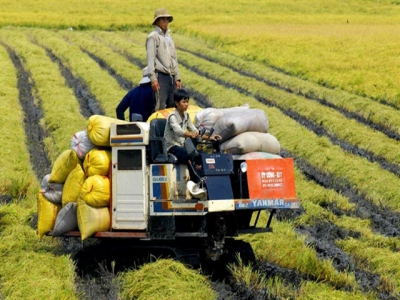An Giang programme for producing rice seeds continues to attract farmers

AN GIANG — More and more farmers in An Giang have been producing quality rice seeds for cultivation since the Cửu Long (Mekong) Delta province launched a programme in 2004 calling on farmers and private investors to invest in this.
Farmers harvest the 2019-20 winter – spring rice in An Giang Province. — VNA/VNS Photo Công Mạo
The country’s second largest rice producer after only another Mekong Delta province, Kiên Giang, grew three rice crops last year on a total area of 680,000ha.
Trần Anh Thư, deputy chairman of the province People’s Committee, said the province is a leader in the country in producing rice seeds, with 4,500 – 6,000 farmers doing so on a total area of 26,000 – 31,000ha a year.
The province has at least one rice seed producing group in each commune and around 30 companies and other entities which grow and trade seeds.
Many farmers are tying up with companies to ensure outlets for their seeds and steady incomes.
The province produces 150,000 – 164,000 tonnes of seeds annually, mostly OM6976, OM4900, jasmine, OM5451, OM9582, and IR50404 varieties.
Besides producing seeds, many farmers have also created new rice strains after getting training in this from the province’s agriculture extension authorities.
Hoa Sĩ Hiền in Tân Châu Town’s Tân An Commune has created more than 50 new varieties that are resistant to drought and saltwater.
Trần Thanh Hùng in Tịnh Biên District’s Núi Voi Commune, in co-operation with Prof Huỳnh Quang Tín of the Cần Thơ University’s Mekong Delta Development Research Institute, has created the AG1 strain with high yields, short-term maturity and tolerance to saltwater and alum in the soil.
AG1, a hybrid of OM6932 and HD1B, has been recognised by the Ministry of Agriculture and Rural Development’s Plant Cultivation Department and is being grown on a pilot basis in An Giang and other delta provinces.
Nguyễn Sĩ Lâm, director of the province Department of Agriculture and Rural Development, said farmers participating in the programme have researched and created many new rice varieties with great potential.
“The programme has helped the province have enough rice seeds for its own cultivation and selling to other provinces. The programme has improved the quality of rice exports in recent years.”
High-quality varieties were grown on 70 per cent of the area under rice in 2018, according to the People’s Committee.
To achieve this rate, the department and other agencies have undertaken many activities in recent years to popularise high-quality varieties.
In each rice crop, the department in co-operation with the Cửu Long Rice Research Institute introduces some high-quality strains that have potential for development locally.
It has encouraged farmers to grow varieties that meet export standards like OM4900, OM6377, OM8927, OM7347, and OM9582.
The province has established concentrated rice growing areas by pooling lands that specialise in high-quality, specialty varieties and glutinous varieties.
It has a 22,500ha glutinous rice-growing area in Phú Tân District and a 1,150ha jasmine rice-growing area in Châu Phú District.
Rice, vegetables and tra fish are the province’s three designated key agricultural produce.
Related news
 Organic rice zone emerged in central Vietnam
Organic rice zone emerged in central Vietnam Farmers and businesses in rural communes of Dien Ban Town in the central province of Quang Nam have been working to develop low-yield rice fields
 Tea exports fall in Q1 due to COVID-19
Tea exports fall in Q1 due to COVID-19 Việt Nam suffered a reduction of tea exports in the first quarter of this year due to the impact of the COVID-19 pandemic
 MoIT issues rice export quotas this month under PM permission
MoIT issues rice export quotas this month under PM permission Minister of Industry and Trade Trần Tuấn Anh has signed on decision announcing the rice export quota for April after the Prime Minister gave the green light